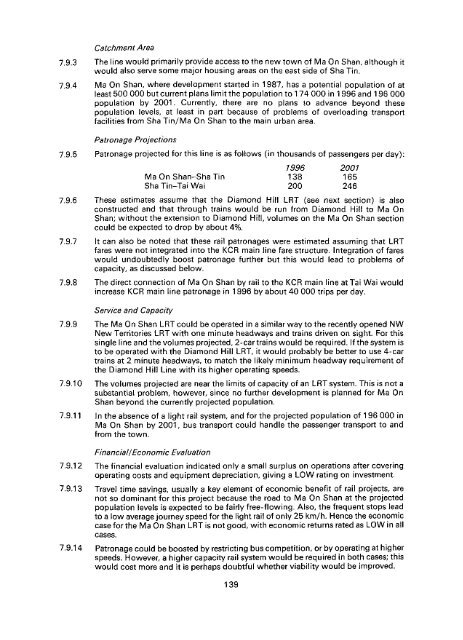Untitled - HKU Libraries - The University of Hong Kong
Untitled - HKU Libraries - The University of Hong Kong
Untitled - HKU Libraries - The University of Hong Kong
- No tags were found...
You also want an ePaper? Increase the reach of your titles
YUMPU automatically turns print PDFs into web optimized ePapers that Google loves.
Catchment Area7.9.3 <strong>The</strong> line would primarily provide access to the new town <strong>of</strong> Ma On Shan, although itwould also serve some major housing areas on the east side <strong>of</strong> Sha Tin.7.9.4 Ma On Shan, where development started in 1987, has a potential population <strong>of</strong> atleast 500 000 but current plans limit the population to 174 000 in 1 996 and 196 000population by 2001. Currently, there are no plans to advance beyond thesepopulation levels, at least in part because <strong>of</strong> problems <strong>of</strong> overloading transportfacilities from Sha Tin/Ma On Shan to the main urban area.Patronage Projections7.9.5 Patronage projected for this line is as follows (in thousands <strong>of</strong> passengers per day):1998 2001Ma On Shan-Sha Tin 138 165Sha Tin-Tai Wai 200 2467.9.6 <strong>The</strong>se estimates assume that the Diamond Hill LRT (see next section) is alsoconstructed and that through trains would be run from Diamond Hill to Ma OnShan; without the extension to Diamond Hill, volumes on the Ma On Shan sectioncould be expected to drop by about 4%.7.9.7 It can also be noted that these rail patronages were estimated assuming that LRTfares were not integrated into the KCR main line fare structure. Integration <strong>of</strong> fareswould undoubtedly boost patronage further but this would lead to problems <strong>of</strong>capacity, as discussed below.7.9.8 <strong>The</strong> direct connection <strong>of</strong> Ma On Shan by rail to the KCR main line at Tai Wai wouldincrease KCR main line patronage in 1996 by about 40 000 trips per day.Service and Capacity7.9.9 <strong>The</strong> Ma On Shan LRT could be operated in a similar way to the recently opened NWNew Territories LRT with one minute headways and trains driven on sight. For thissingle line and the volumes projected, 2-car trains would be required. If the system isto be operated with the Diamond Hill LRT, it would probably be better to use 4-cartrains at 2 minute headways, to match the likely minimum headway requirement <strong>of</strong>the Diamond Hill Line with its higher operating speeds.7.9.10 <strong>The</strong> volumes projected are near the limits <strong>of</strong> capacity <strong>of</strong> an LRT system. This is not asubstantial problem, however, since no further development is planned for Ma OnShan beyond the currently projected population.7.9.11 In the absence <strong>of</strong> a light rail system, and for the projected population <strong>of</strong> 196 000 inMa On Shan by 2001, bus transport could handle the passenger transport to andfrom the town.Financial/Economic Evaluation7.9.12 <strong>The</strong> financial evaluation indicated only a small surplus on operations after coveringoperating costs and equipment depreciation, giving a LOW rating on investment.7.9.13 Travel time savings, usually a key element <strong>of</strong> economic benefit <strong>of</strong> rail projects, arenot so dominant for this project because the road to Ma On Shan at the projectedpopulation levels is expected to be fairly free-flowing. Also, the frequent stops leadto a low average journey speed for the light rail <strong>of</strong> only 25 km/h. Hence the economiccase for the Ma On Shan LRT is not good, with economic returns rated as LOW in allcases.7.9.14 Patronage could be boosted by restricting bus competition, or by operating at higherspeeds. However, a higher capacity rail system would be required in both cases; thiswould cost more and it is perhaps doubtful whether viability would be improved.139
















